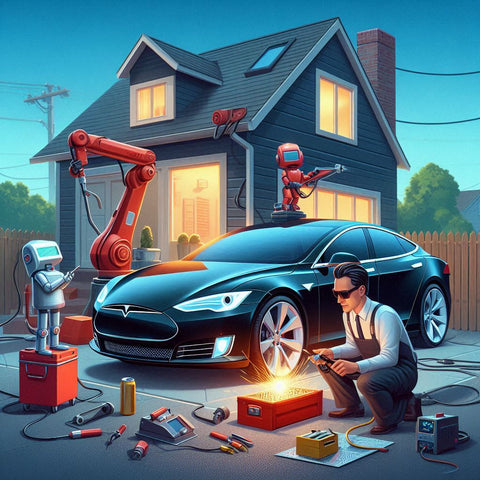
Manufactured Homes: Would Tesla build your new car, on your front lawn?
So, you’re looking to buy a new home, rental, bach, staff accommodation, farmhouse, or setup a tourism project?
You have heard about prefab, but what about kitset? Tiny homes? On-site? Modular? Or Panelised builds?
Even companies popping up in our space of low-energy sustainable prefab, but not everything is as it seems, read on to find out why.
On-site: the traditional construction method, is notorious for delays from mismanagement, weather, wasted materials, excessive noise, pollution and poor-quality workmanship and material choices.
It can also be very hard to navigate and manage in cities let alone rural and remote locations.


Panelised construction: Certainly goes a long way to reducing these problems, but you still need to find a local qualified team who is confident in the systems, have a good weather window, and line up all your subtrades to complete electrical, plumbing, plastering, tiling, painting and the likes in the wild – when prefab is not an option due to site access or uniqueness of the design this is certainly the most effective solution and we would highly recommend contacting our panel supplier NZSIP to discuss the options.
Kitset: – Touted as the Ikea of building, but you will still face many of the problems above, and it is unlikely you will get a high performance low-energy build that also considers your health, comfort, and the environmental impact

Tiny-Homes: – While they can be cute, unquie, have innovative designs for storage and function, and offer lower barriers to entry than a traditional house they can be also be a minefield with consents, insurance, lending and with limited space not always suitable for a growing family. Usually built on trailers to be towed by an everyday Ute, they need to be compact and light at 3500kg complete to abide by road regulations (our builds start at 11T). So usually they only built to or below building code for this reason and to keep costs down.

Container Homes: Great for temporary site offices, emergency shelters, toilet blocks and one done correctly can be a great home, but they are made from relatively thin steel so are fraught with complexities of engineering, moisture, temperature management and carbon cost (steel production is very energy intensive).
Many examples are popping up in China and elsewhere around the world, but few will meet NZ building code, they usually have poor environmental and construction ethics, and face potential saltwater corrosion during transport if coming from abroad.

Modular: Where prefab meets scale, great if you need a larger home, or the ability to grow in the future to meet your needs.
Not quite as cost effective as a fully finished prefab as it will require on site connection of the modules, but this gives you more flexibility on the size and layout of your home.


Prefab (prefabrication): Since the early 60’s kiwis have been working on Prefab, many of our major infrastructure projects like Hydro dams have relied on it for staff housing, but it was notorious for poor quality with fast and cheap being the top priorities - not what you would call a homely house, but times have changed and there are now stylish prefab manufacturers in New Zealand and you can see why below.
As a start to finish prefab manufacturing facility at Árbol we can control more of the variables – from weather by mostly working undercover, material storage to quality control for all trades and multiple builds managed from a single location.

As a single point of operation – we don’t have a project manager running around the region to check each build, they simply walk out the office door into the production line.
Specialist equipment and tools on hand always like forks lifts for ease of maneuvering heavy items, extra scaffolding, a multitude of ladders, dedicated workstations for cutting, thickening, painting, and so on.

In general all our dwellings are fully finished before leaving our facility including all painting and tiling, ensuring the best quality product is delivered to you without delay.
Reuse, recycling of metal, soft & hard plastics, cardboard, polystyrene, and glass. We greatly reduce our landfill waste.
All this resulting in a faster and higher quality product for you, with reduced impact to our team and the environment.
But we go further than just architectural Prefab with The Árbol Difference™.
We focus on your comfort foremost with stable warm temperatures year around, no excess moisture, and durable reduced toxin material choices.
So, you are healthier and happier with reduced power bills and more free time.
We are high quality, low energy, reduced maintenance, environmentally responsible, architecturally designed, fully finished prefabricated & modular transportable homes.
Now that’s a mouth full, but we spell it out, because we are unquie to New Zealand, as we are a complete eco system – others might claim they do, but no one else ticks all these boxes and backs it up with the data, and has produced the volume of product we have - make sure you're comparing apples with apples when looking at price and specifications - ask to see the evidence.

Others may say they build energy efficient, healthy, eco homes or sustainable homes, but most are greenwashing – how can a new home be truly sustainable, we strive to be responsible, adding solar panels doesn’t make up for the condensation on the windows, poor insulation levels, or Heatpump running all the time and just because your building Passive House, did you consider that toxic paint, glues, or longevity of the cedar you chose for the cladding?
How about the finishing quality? Some others just cherry pick items like better insulation, and ventilation, but skip a matching performance window suite for a flashy benchtop.
Although we don’t certify all our builds to Passive House standard, we do use Passive House and Homestar certified architects, trades people and use many Passive House certified brands and materials during the construction to achieve our high-performance builds.
- All our builds feature an up to average of 40% more insulation than NZBC, an airtight building envelope, uPVC windows, Low-E / Lightbridge Glazing, Mechanical Ventilation Heat Recovery units (MVHR), and reduced thermal bridging - as standard.
You need the complete system otherwise you risk excessive moisture and poor airtightness.
- We baseline our homes with PHHP (Passive House Planning Suite) for 35-55 kW/m2a heating demand
See the data below from our clients Pohutukawa in Alexandra – this is the ultimate test in one of the most extreme climates in New Zealand of up to +38C in Summer and -11c in Winter.

Five times lower heating demand than new NZBC H1 2024 standards.

Overheating of up to 40% less than NZBC
- Blower door testing that exceeds Passive House Standard of 0.65ACH (air changes per hour).
The lower this number the less energy is escaping your home.
Our most recent was 0.53ACH our smallest dwelling our 40m2 / 107m3 Rata cabin, this was a complex feat and many of the best in the high performance sector doubted we could achieve it.
Our next target is 0.30ACH pr lower - we have new window suites coming to make it a reality shortly.

- Calculate our LCA (Life Cycle Analysis) to greatly reduce carbon emissions – Our Pohutukawa for example is 58 tons of total LCA carbon emissions VS 172 tons at BRANZ standard reference.

- Review client builds and gather real life data from their experiences to better our product.
- We can Homestar certify builds on request - all are builds will already meet 7 or greater as standard.
- Passive House certified versions of our builds are also available on request, and will be uniquely specified and constructed to your site-specific requirements. Watch out for the those claiming "Passive House Principles" it's not the same thing.
- All our builds are engineered from the ground up to be transportable, and built for high wind and snow zone as standard for the ultimate in durability – we go above and beyond with up to five thousand screw fixings in our Pohutukawa for example. Others in the prefab sector have hidden fees in their schedules to repair the damage from transport, this is because they predominately use nail based fixings and lack additional bracing.



All this effort results in a higher quality product for you, with faster delivery and reduced impact to our team and the environment.
We do not offer standard building code, on-site or kitset builds for these reasons.
So, what’s the catch with prefab? Delivery, we have tackled some very complex sites, steep driveways, narrow bridges, even across the Clyde dam twice and through the Buller gorge, but occasionally it’s just not possible. Some dimensions and build shapes just don’t make sense either. In both these situations we recommend contacting NZSIP for panelised construction on-site with a conscious build team.

We don’t claim to be perfect, but we are real, not just pretty renders or words, next week (July 23rd 2024) we will deliver our 20th low-energy build. We work on action and strive to be better every day, we are just at the start of an evolution, we foster new ideas, and learn from the data, and leverage our manufacturing based approach to make changes and improve processes and our product quickly.
So back to our original question: Would Telsa build your new car on your front lawn? Well they could, but they wouldn't because it would be inefficient, result in inconsistent quality, costing them, you and the environment a lot more.
Be the difference you want to see in the world, consider Árbol for your next abode!

